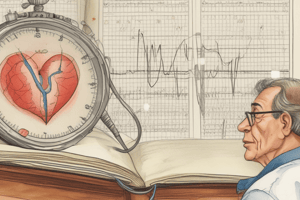Podcast
Questions and Answers
What occurs when both the SA node and the AV junctional tissues fail to generate an impulse?
What occurs when both the SA node and the AV junctional tissues fail to generate an impulse?
- The ventricles assume the role of pacing the heart (correct)
- The atria take over pacing
- The heart stops beating
- The heart rhythm becomes normal
What is an absence of P waves indicative of?
What is an absence of P waves indicative of?
No atrial activity or depolarization
What is the rate range of idioventricular rhythm?
What is the rate range of idioventricular rhythm?
20-40 bpm
Which of the following is NOT considered a lethal rhythm?
Which of the following is NOT considered a lethal rhythm?
PVC's appear in many different patterns and shapes, but are always _____ and bizarre compared to a 'normal' beat.
PVC's appear in many different patterns and shapes, but are always _____ and bizarre compared to a 'normal' beat.
What are some common causes of PVC's?
What are some common causes of PVC's?
Which of the following nursing interventions is essential for a patient experiencing frequent PVC's?
Which of the following nursing interventions is essential for a patient experiencing frequent PVC's?
Agonal rhythm is characterized by a rate of 20 beats or less per minute.
Agonal rhythm is characterized by a rate of 20 beats or less per minute.
What are the primary signs and symptoms of agonal rhythm?
What are the primary signs and symptoms of agonal rhythm?
Which medical treatment is recommended for idioventricular rhythm?
Which medical treatment is recommended for idioventricular rhythm?
Match the following types of ventricular rhythms with their characteristics:
Match the following types of ventricular rhythms with their characteristics:
Flashcards are hidden until you start studying
Study Notes
Ventricular Rhythms Overview
- Occur when SA node and AV junction fail to generate impulses, leading ventricles to pace the heart.
- Characterized by absence of P waves, indicating lack of atrial activity.
- QRS complexes are wide (≥ 0.12 seconds) and exhibit a bizarre appearance.
Types of Ventricular Rhythms
- Premature Ventricular Contractions (PVCs) are non-rhythmic ectopic beats from irritated ventricular sites.
- Lethal ventricular rhythms include:
- Idioventricular rhythm: Rate 20-40 bpm.
- Accelerated idioventricular rhythm: Rate > 40 bpm.
- Agonal rhythm: Rate ≤ 20 bpm.
- Ventricular Fibrillation.
- Torsades de Pointes.
- Pulseless Electrical Activity (PEA).
- Asystole: Cardiac standstill.
Premature Ventricular Contractions (PVCs)
- PVCs appear as various wide and bizarre patterns, compared to normal beats.
- Typically do not alter the overall rhythm despite their irregularity.
Identifying PVCs
- Rate generally normal, but varies with underlying rhythm.
- No P waves; can't measure PRI.
- QRS complexes are wide (> 0.12 seconds) and present early.
Causes and Symptoms of PVCs
- Causes: Exercise, stress, caffeine, myocardial infarction (MI), congestive heart failure (CHF), cardiomyopathy, mitral valve prolapse, electrolyte imbalances, hypoxia, tricyclic antidepressants, digitalis toxicity.
- Symptoms: Palpitations, weakness, dizziness, hypotension (HoTN).
Nursing Interventions for PVCs
- Assess patient and administer 2 liters of oxygen as it may reduce PVCs.
- Start IV and hang normal saline (NS).
- Monitor for frequency of PVCs and watch for progression to more severe rhythms.
Idioventricular Rhythm (Ventricular Escape Rhythm)
- The ventricles attempt to prevent cardiac standstill with a rate of 20-40 bpm, resulting in compromised cardiac output.
- Rhythm is regular; P waves absent and PRI not measurable.
- QRS complexes are wide and bizarre with T wave deflection.
Causes and Symptoms of Idioventricular Rhythm
- Causes: Digitalis drugs, myocardial infarction, metabolic imbalances, hyperkalemia, cardiomyopathy.
- Symptoms: Pale and cool skin with mottling, weakness, dizziness, hypotension, altered mental status.
Medical Treatment for Idioventricular Rhythm
- Treatments include Atropine, pacing, dopamine for hypotension, and CPR.
Nursing Interventions for Idioventricular Rhythm
- Conduct an assessment as patients will likely show symptoms of weakness and thready pulses.
- Continuous ECG monitoring is essential; initiate CPR, call CODE BLUE, notify the physician, and start an IV with NS.
Accelerated Idioventricular Rhythm
- Serves as a compensatory mechanism with a rate of 40-100 bpm, compromising cardiac output.
- No P waves, PRI unmeasurable, QRS wide and bizarre with T wave deflection.
Causes and Symptoms of Accelerated Idioventricular Rhythm
- Causes include Digitalis drugs, myocardial infarction, metabolic imbalances, hyperkalemia, cardiomyopathy.
- Symptoms: Skin may appear pale and cool, with mottling; patient might feel weak with dizziness, hypotension, and altered mental status.
Medical Treatment for Accelerated Idioventricular Rhythm
- Similar to idioventricular rhythm, includes Atropine, pacing, dopamine if hypotensive, and CPR.
Nursing Interventions for Accelerated Idioventricular Rhythm
- Assess the patient for typical symptoms with a weak, thready pulse.
- Continuous ECG monitoring is required; CPR should be initiated, and CODE BLUE called while preparing IV and NS.
Agonal Rhythm
- Represents an extreme decline in heart rate (≤ 20 bpm) often seen as a final heart rhythm when resuscitation is failing.
Identifying Agonal Rhythm
- Assess ventricular rate and review ECG characteristics: wide QRS and T wave deflection.
Causes and Symptoms of Agonal Rhythm
- Causes: Trauma, acute myocardial infarction, progression towards death.
- Symptoms include loss of consciousness and lack of palpable pulse or measurable blood pressure.
Risks and Medical Treatment for Agonal Rhythm
- Major risk associated is death.
- Medical treatment includes CPR and adherence to Advanced Cardiac Life Support (ACLS) protocols, with cessation of further treatment if resuscitation efforts are unsuccessful.
Nursing Interventions for Agonal Rhythm
- Primary focus on assessing the patient's status and running emergency protocols.
Studying That Suits You
Use AI to generate personalized quizzes and flashcards to suit your learning preferences.




